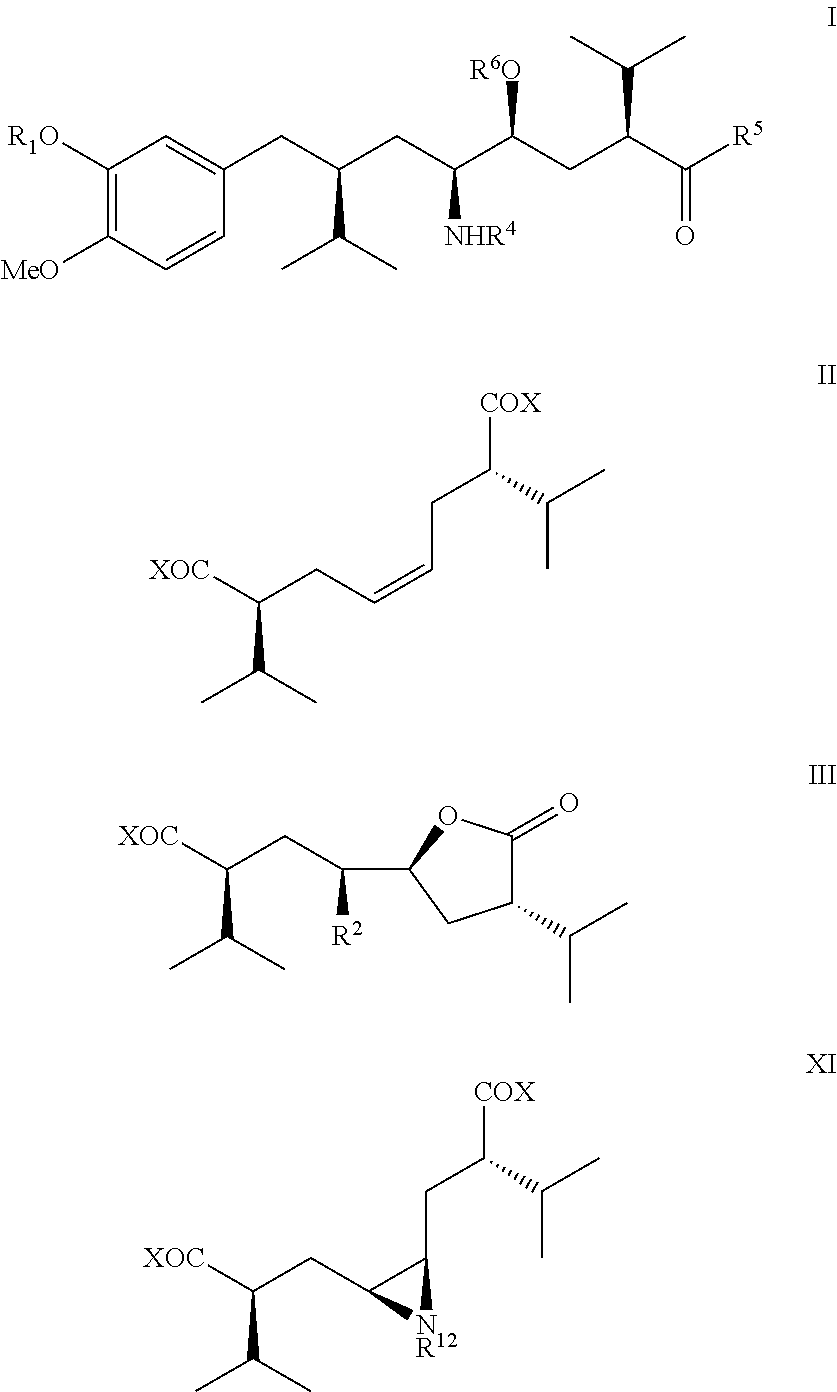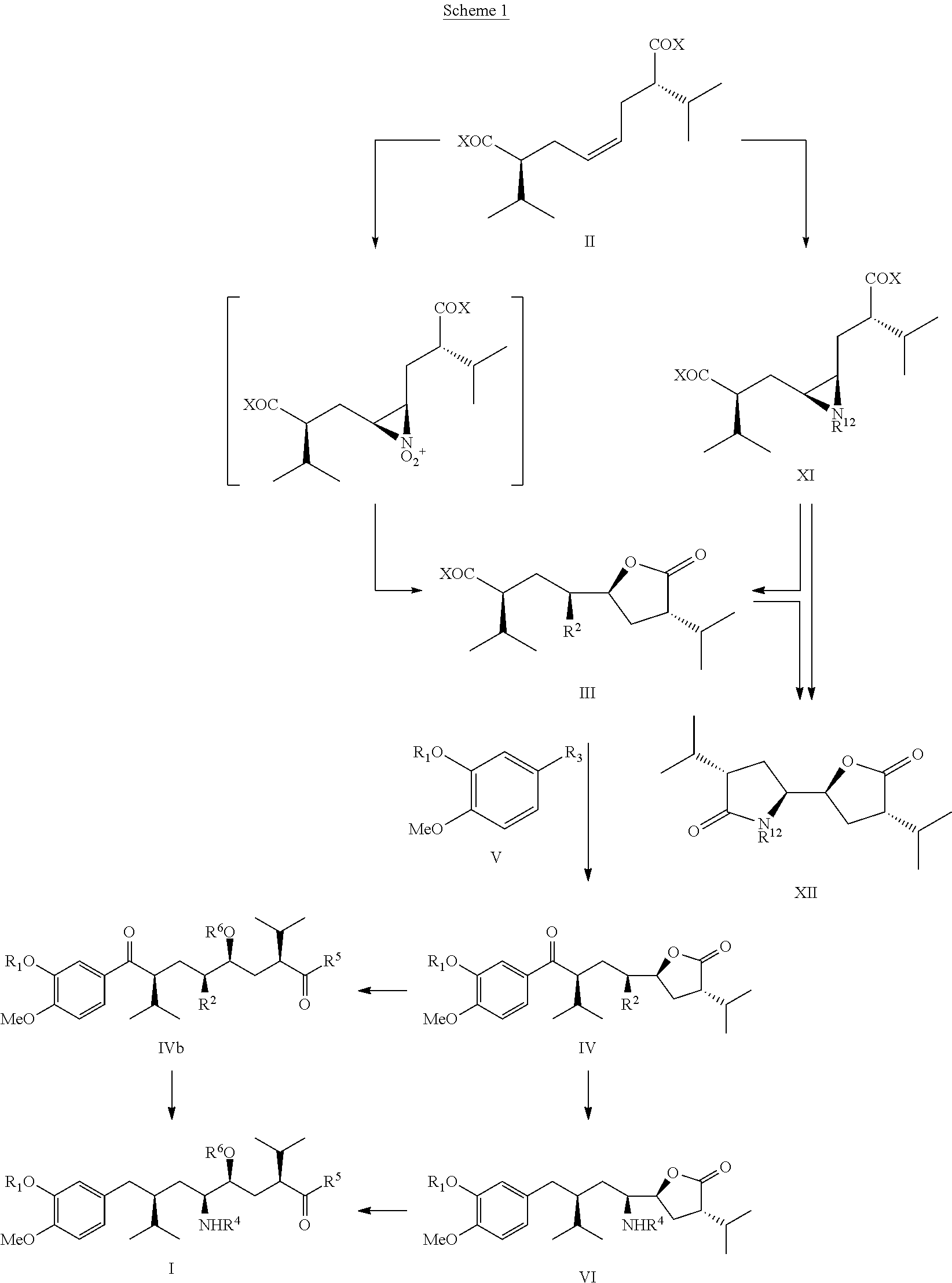Process for enantiomerically pure 8-Aryloctanoic acids as Aliskiren
a technology of aliskiren and aryloctanoic acid, which is applied in the preparation of carboxylic acid amides, chemistry apparatus and processes, and organic chemistry, etc., can solve the problems of complex synthesis of enantiomerically pure compounds and none of them meet the requirements of a short and cost effective manufacturing process, and achieves efficient preparation, simple sequence of steps, and efficient formation
- Summary
- Abstract
- Description
- Claims
- Application Information
AI Technical Summary
Benefits of technology
Problems solved by technology
Method used
Image
Examples
example 1
Preparation of cis-2(S),7(S)-diisopropyl-octe-4-enedioic acid (IIb) from VIIIa
[0067]To a solution of 4(S)-benzyl-3-isovaleroyl-oxazolidin-2-one (12 g, THL 2000, 41, 10085), dissolved in THF (80 ml), under inert atmosphere cooled to −70° C. 1M-solution of lithium hexamethyldisilazide in toluene (LiHMDS, 50 ml) was slowly added dropwise under stirring at −70° C. within a period of ca. 1 hr. After stirring at the same temperature for 1 hr the reaction mixture was wormed to 0° C., then again cooled down to −70° C. and cis-1,4-dibromo-but-2-ene (4.5 g) in THF (10 ml) was slowly added, the reaction mixture shortly stirred at −70° C., then warmed to it and stirred for 7 hrs and finally poured on mixture of ice water and saturated sodium chloride solution (400 ml, 1:1). The aqueous phase was extracted 3 times with ethylacetate (3×200 ml), the combined organic phases washed once with saturated sodium bicarbonate solution (200 ml), dried with sodium sulphate, filtered and the filtrate evapora...
example 2
Preparation of Compound (IIIc) from Compound (IIb) Using AcONO2
[0068]90% Nitric acid (10 g) was very slowly dropped into stirred and ice bath cooled acetic anhydride (60 g) at such a rate that the reaction temperature was maintained at it and then the solution then stirred for 20 min. This was followed by dropwise addition of cis-2(S),7(S)-2,7-diisopropyloct-4-enedioic acid (IIa, 25 g), dissolved in acetic acid (10 ml), within ca. 1 hr and continuous cooling with ice bath in order to maintain the temperature at rt. After stirring for 1 hr at rt, the reaction mixture was poured carefully on a mixture of ice and water (ca. 200 ml), the aqueous phase extracted 3 times with methylenechloride
[0069](3×200 ml), the combined organic phases washed twice with water (2×200 ml), then dried over MgSO4, filtered and evaporated under vacuum. The crude residue was dried on high vacuum to remove last traces of acetic acid and anhydride providing the title compound (IIIc) with a structure as indicat...
example 3
Preparation of Compound (IIIc) from Compound (IIb) using CAN ((NH4)2Ce(NO3)5.4H2O)
[0070]A mixture of cis-2(S),7(S)-2,7-diisopropyloct-4-enedioic acid (IIa, 2.5 g) and CAN (1.7 g) in acetic anhydride (8 ml) was stirred at rt for 10 hrs, then the reaction mixture poured on crushed ice (100 g) and the aqueous phase extracted 3 times with ethylacetate (3×100 ml). The combined organic phases were washed once with water (100 ml), dried over MgSO4, filtered and evaporated under vacuum. The crude residue was finally dried on high vacuum to remove last traces of acetic acid / anhydride providing the title compound (111c) with a structure as indicated in the Scheme above as brown oil: 1.7 g (57% isolated yield) with analytical data identical with the product prepared as given in Example 2.
PUM
| Property | Measurement | Unit |
|---|---|---|
| temperature | aaaaa | aaaaa |
| pressure | aaaaa | aaaaa |
| temperature | aaaaa | aaaaa |
Abstract
Description
Claims
Application Information
 Login to View More
Login to View More - R&D
- Intellectual Property
- Life Sciences
- Materials
- Tech Scout
- Unparalleled Data Quality
- Higher Quality Content
- 60% Fewer Hallucinations
Browse by: Latest US Patents, China's latest patents, Technical Efficacy Thesaurus, Application Domain, Technology Topic, Popular Technical Reports.
© 2025 PatSnap. All rights reserved.Legal|Privacy policy|Modern Slavery Act Transparency Statement|Sitemap|About US| Contact US: help@patsnap.com



